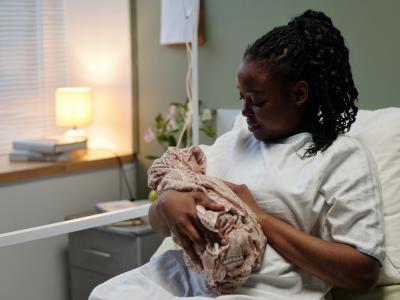Minorities bore brunt of COVID among young Americans early in pandemic
Racial and ethnic disparities in COVID-19 infection rates were significant among Americans younger than 25 years early in the pandemic, particularly for Native Hawaiian/Pacific Islander, American Indian/Alaska Native, and Hispanic people, according to a study today in Morbidity and Mortality Weekly Report (MMWR).
Researchers from the US Centers for Disease Control and Prevention (CDC) and state health departments analyzed data from 689,672 young COVID-19 patients in 15 states and Washington, DC, by age and sex during three pandemic periods.
From January to April 2020, racial and ethnic minorities had significantly higher rates of COVID-19 than did the White population (rate ratio [RR], 1.09 to 4.62). From May to August, the RR rose from 2.49 to 4.57 among Native Hawaiian/Pacific Islanders but fell for Asian, Black, and multiracial populations (RR, 0.52 to 2.82).
Disparities decreased from September to December (RR, 0.37 to 1.69), mostly owing to a 320% rise in COVID-19 infections among White people rather than a drop among racial minorities.
"Ensuring equitable and timely access to preventive measures, including testing, safe work and education settings, and vaccination when eligible is important to address racial/ethnic disparities," the authors concluded.
The large racial and ethnic differences in COVID-19 infections could be due to a lesser ability to work from home because of holding essential jobs and higher odds of living in a multigenerational home, the researchers said.
They called for further research into whether state pandemic mitigation policies could have led to differential compliance with public health measures according to race and whether the use of strategies such as repeated testing of students in some academic settings might have differed over time according to race and ethnicity.
Mar 10 MMWR study
Long COVID-19 tied to certain symptoms, having more than 5 symptoms
A new study out of the United Kingdom found people who developed "long COVID-19," meaning they experienced symptoms for more than 28 days after initial infection, were more likely to report more than five symptoms in the early days of their illnesses, and long COVID-19 was also tied to certain early symptoms. The study was published today in Nature Medicine.
The findings were based on user data from a mobile app called COVID Symptom Study. A total of 4,182 incident cases of COVID-19, in which individuals self-reported their symptoms, showed that 558 (13.3%) participants reported symptoms lasting more than 28 days, 189 (4.5%) for more than 8 weeks and 95 (2.3%) for more than 12 weeks.
Users who experienced fatigue, headache, difficulty breathing, hoarse voice, and muscle ache during the first week of illness were most likely to suffer from symptoms after 28 days (odds ratios [ORs] ranging from 2.22 to 2.83).
Experiencing five or more of any type of symptom during the first week of illness was also associated with developing long COVID (OR, 3.53; 95% confidence interval, 2.76 to 4.50), the authors said. Increasing age, body mass index, and being female was also associated with developing long COVID. Asthma was the only preexisting condition tied to long COVID.
The authors warned, however, that findings were limited by app users. "App users were disproportionately female, and those over 70 years of age were underrepresented, which could increase or decrease our estimate of the prevalence and duration of long COVID."
Mar 10 Nat Med study
Pneumococcal vaccine associated with lower COVID-19 risk
People 65 and older who received the 13-valent (13-strain) pneumococcal conjugate vaccine (PCV13) had lower COVID-19 diagnoses, hospitalizations, and deaths, reports a study published yesterday in The Journal of Infectious Diseases. If patients received antibiotics within the past 90 days, though, the relationship weakened.
The researchers looked at 541,033 elderly adults in the Kaiser Permanente Southern California healthcare system from Mar 1 to Jul 22, 2020. The vast majority (83.4%) received PCV13, and recipients were more likely to be older, have more comorbidities, and partake in healthcare services more often. Overall, 3,677 COVID-19 cases in the study cohort (0.7%) led to 1,075 hospitalizations (0.2%) and 334 deaths (0.06%).
Using adjusted hazard ratios (aHRs) calculated with Cox proportional hazards regression, the researchers found that people who received PCV13 had aHRs of 0.65 (95% confidence interval [CI], 0.59 to 0.72), 0.68 (95% CI, 0.57 to 0.83), and 0.68 (95% CI, 0.49 to 0.95) for COVID infection, hospitalization, and death, respectively. The researchers also found, however, that this relationship deteriorated if the person received antibiotics within 90 days, going from an aHR of 1.06 to 1.14 until after day 90, where it was 0.65 and lower.
No relationship was found between COVID-19 risk and receipt of the other recommended vaccine, the 23-valent pneumococcal polysaccharide vaccine.
"Similarity of PCV13 effect estimates across all three outcomes suggests that protection arose from the prevention of early stages of COVID-19 pathogenesis rather than prevention of severe post-infection sequelae, which would have led to higher effectiveness estimates against hospitalization and death," the researchers write. "Our results are in agreement with other data suggesting the pathogenicity of respiratory viruses may be modified by bacterial carriage."
Mar 9 J Infect Dis study
Lung aspergillosis in severe COVID-19 linked to worse outcomes
Aspergillosis, a fungal infection that commonly affects the lungs, is associated with worse COVID-19 outcomes, including longer hospital stay and oxygen therapy, according to a study yesterday in Clinical Infectious Diseases.
The researchers looked at a retrospective cohort of COVID-19 patients who needed mechanical ventilation in five Johns Hopkins hospitals from March to August 2020. Of the 396 patients, 9.8% people had probable (20) and possible (19) COVID-19–associated pulmonary aspergillosis (CAPA). CAPA patients were more likely to have health conditions such as pulmonary vascular disease (41.0% vs 26.1%), coagulopathy (51.3% vs 33.1%), solid tumors (35.6% vs 10.9%), and corticosteroid treatment during initial admission (66.7% vs 42.6%).
Hydrocortisone was the only corticosteroid more likely to be prescribed to CAPA patients, but the researchers note that its use may be an indicator of COVID severity, not a risk factor of CAPA development.
Overall, CAPA patients had a slower recovery by an adjusted odds ratio of 1.09, write the researchers. For instance, CAPA patients were extubated twice as slowly and progressed in severity scores from 6 (prompting intubation) to 7 (requiring another form of advanced life support) 1.8 times faster.
They also required longer periods of oxygen therapy (median 40.7 days vs 16.7 in those without), ventilator support (36.6 days vs 8.9), vasopressors (24.8 vs 6.2), extracorporeal membrane oxygenation therapy (55.4 vs 14.9), and hospital stay (41.1 vs 18.5). Approximately 50% of people with CAPA received antifungal agents.
"We suspect that the low rate of [antifungal] treatment was likely from lack of recognition in this emerging condition and difficulty in differentiation between invasive mold disease and colonization without standardized definitions, particularly in early COVID-19 pandemic," the researchers write. "Given difficulties in invasive sampling, improved non-invasive diagnostics that enable screening and/or prophylactic antifungal therapy may be warranted in high-risk patients to improve COVID-19 outcomes."
Mar 9 Clin Infect Dis study














